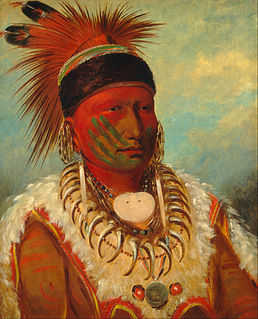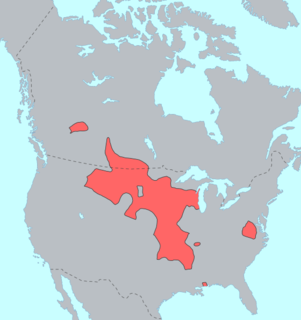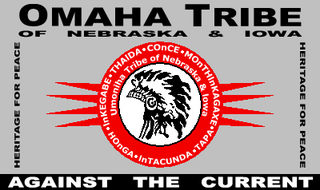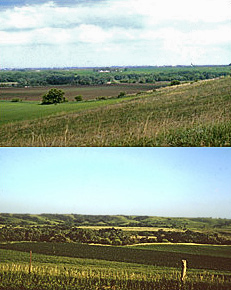
As general terms, Indian Territory, the Indian Territories, or Indian country describe an evolving land area set aside by the United States Government for the relocation of Native Americans who held aboriginal title to their land. In general, the tribes ceded land they occupied in exchange for land grants in 1803. The concept of an Indian Territory was an outcome of the 18th- and 19th-century policy of Indian removal. After the Civil War (1861–1865), the policy of the government was one of assimilation.

The Kaw Nation are a federally recognized Native American tribe in Oklahoma and parts of Kansas. They come from the central Midwestern United States. The tribe known as Kaw have also been known as the "People of the South wind", "People of water", Kansa, Kaza, Kosa, and Kasa. Their tribal language is Kansa, classified as a Siouan language.

The Iowa or Ioway, known as the Báxoǰe in their own language, are a Native American Siouan people. Today, they are enrolled in either of two federally recognized tribes, the Iowa Tribe of Oklahoma and the Iowa Tribe of Kansas and Nebraska.

Arikara, also known as Sahnish, Arikaree or Hundi, are a tribe of Native Americans in North Dakota. Today, they are enrolled with the Mandan and the Hidatsa as the federally recognized tribe known as the Mandan, Hidatsa, and Arikara Nation.

The Western Siouan languages, also called Siouan proper or simply Siouan, are a large language family native to North America. They are closely related to the Catawban languages, sometimes called Eastern Siouan, and together with them constitute the Siouan (Siouan–Catawban) language family.
The Ponca are a Midwestern Native American tribe of the Dhegihan branch of the Siouan language group. There are two federally recognized Ponca tribes: the Ponca Tribe of Nebraska and the Ponca Tribe of Indians of Oklahoma. Their traditions and historical accounts suggest they originated as a tribe east of the Mississippi River in the Ohio River valley area and migrated west for game and as a result of Iroquois wars.

The Omaha are a federally recognized Midwestern Native American tribe who reside on the Omaha Reservation in northeastern Nebraska and western Iowa, United States. The Omaha Indian Reservation lies primarily in the southern part of Thurston County and northeastern Cuming County, Nebraska, but small parts extend into the northeast corner of Burt County and across the Missouri River into Monona County, Iowa. Its total land area is 796.355 km2 (307.474 sq mi) and a population of 5,194 was recorded in the 2000 census. Its largest community is Macy.

The Quapaw people are a tribe of Native Americans that coalesced in the Midwest and Ohio Valley. The Dhegiha Siouan-speaking tribe historically migrated from the Ohio Valley area to the west side of the Mississippi River and resettled in what is now the state of Arkansas; their name for themselves refers to this migration and traveling downriver.

Francis La Flesche was the first professional Native American ethnologist; he worked with the Smithsonian Institution. He specialized in Omaha and Osage cultures. Working closely as a translator and researcher with the anthropologist Alice C. Fletcher, La Flesche wrote several articles and a book on the Omaha, plus more numerous works on the Osage. He made valuable original recordings of their traditional songs and chants. Beginning in 1908, he collaborated with American composer Charles Wakefield Cadman to develop an opera, Da O Ma (1912), based on his stories of Omaha life, but it was never produced. A collection of La Flesche's stories was published posthumously in 1998.
Joseph LaFlesche, also known as E-sta-mah-za or Iron Eye (1822–1888), was the last recognized head chief of the Omaha tribe of Native Americans who was selected according to the traditional tribal rituals. The head chief Big Elk had adopted LaFlesche as an adult into the Omaha and designated him in 1843 as his successor. LaFlesche was of Ponca and French Canadian ancestry; he became a chief in 1853, after Big Elk's death. An 1889 account said that he had been the only chief among the Omaha to have known European ancestry.

The Ponca Tribe of Nebraska is one of two federally recognized tribes of Ponca people. The other is the Ponca Tribe of Indians of Oklahoma.

The Blood Run Site is an archaeological site on the border of the US states of Iowa and South Dakota. The site was essentially populated for 8,500 years, within which earthworks structures were built by the Oneota Culture and occupied descendant tribes such as the Ioway, Otoe, Missouri, and shared with Quapaw and later Kansa, Osage, and Omaha people. The site was so named on account of the iron-stained soil.

Big Elk, also known as Ontopanga (1770–1846/1853), was a principal chief of the Omaha tribe for many years on the upper Missouri River. He is notable for his oration delivered at the funeral of Black Buffalo in 1813.
A Half-Breed Tract was a segment of land designated in the western states by the United States government in the 19th century specifically for Métis of American Indian and European or European-American ancestry, at the time commonly known as half-breeds. The government set aside such tracts in several parts of the Midwestern prairie region, including in Iowa Territory, Nebraska Territory, Kansas Territory, Minnesota Territory, and Wisconsin Territory.

Native American tribes in the U.S. state of Nebraska have been Plains Indians, descendants of succeeding cultures of indigenous peoples who have occupied the area for thousands of years. More than 15 historic tribes have been identified as having lived in, hunted in, or otherwise occupied territory within the current state boundaries.
The Dhegihan languages are a group of Siouan languages that include Kansa–Osage, Omaha–Ponca, and Quapaw. Their historical region included parts of the Ohio and Mississippi River Valleys, the Great Plains, and southeastern North America. The shared Dhegihan (Degihan) migration history and separation story places them as a united group in the late 1600s near the confluence of the Ohio and Tennessee rivers (southern Illinois and western Kentucky, which then moved westward towards the Missouri river, and separated into different bands.

American Indians of Iowa include numerous Native American tribes and prehistoric cultures that have lived in this territory for thousands of years. There has been movement both within the territory, by prehistoric cultures that descended into historic tribes, and by other historic tribes that migrated into the territory from eastern territories. In some cases they were pushed by development pressure and warfare.
Kansa is a Siouan language of the Dhegihan group once spoken by the Kaw people of Oklahoma. The last mother-tongue speaker, Walter Kekahbah, died in 1983.

Quapaw, or Arkansas, is a Siouan language of the Quapaw people, originally from a region in present-day Arkansas. It is now spoken in Oklahoma.


![Detail of French cartographer De L'isle 1718 map with points of interest made light. Lower right: The villages of "Maha" (the Omaha Indians) extends up "R[iviere] du Rocher" or Rock River, assumed present-day Big Sioux River. On the east side of the river is an Iowa village. Upper left: "Les Omaha Nation errante" (The wandering Omaha Nation) moved around in present-day South Dakota. This may in fact be the separated Ponca, not yet recognized as a tribe in its own right Detail of the 1718 De L'isle map. Location of Maha (the Omaha Indians) and Les Maha Nation errente.png](http://upload.wikimedia.org/wikipedia/commons/c/c5/Detail_of_the_1718_De_L%27isle_map._Location_of_Maha_%28the_Omaha_Indians%29_and_Les_Maha_Nation_errente.png)













